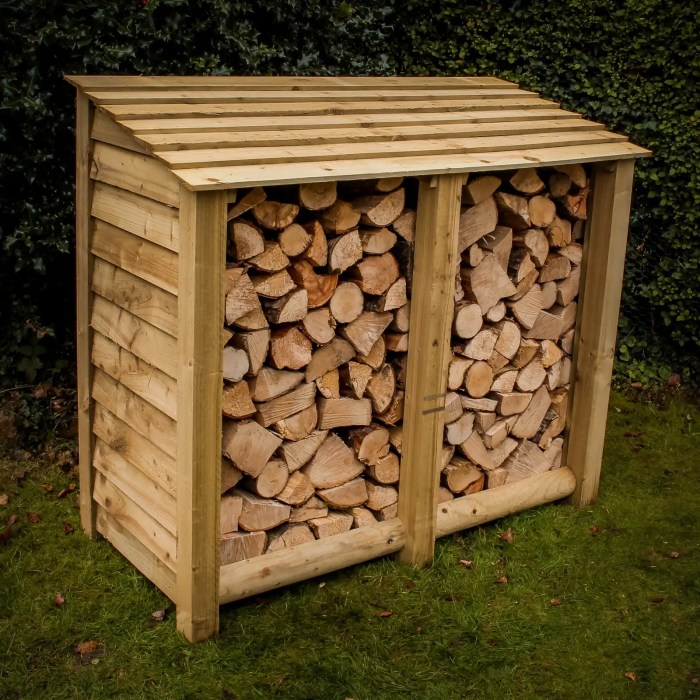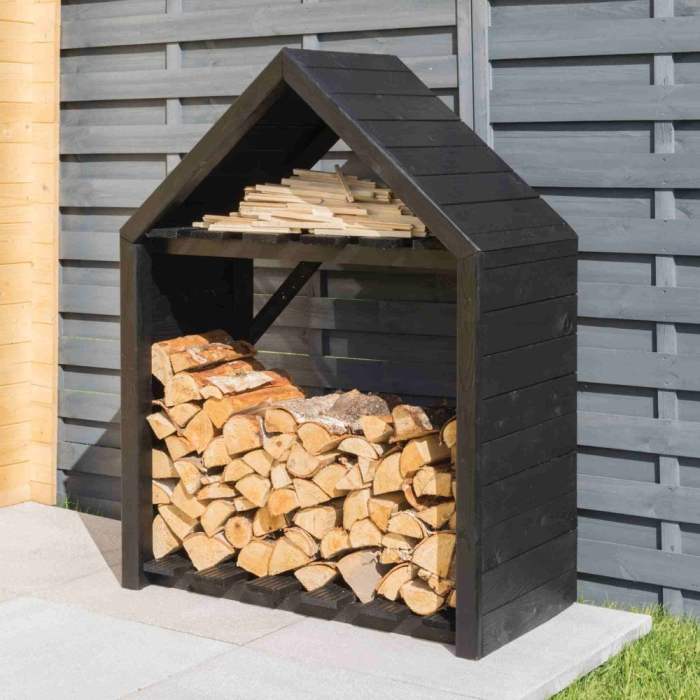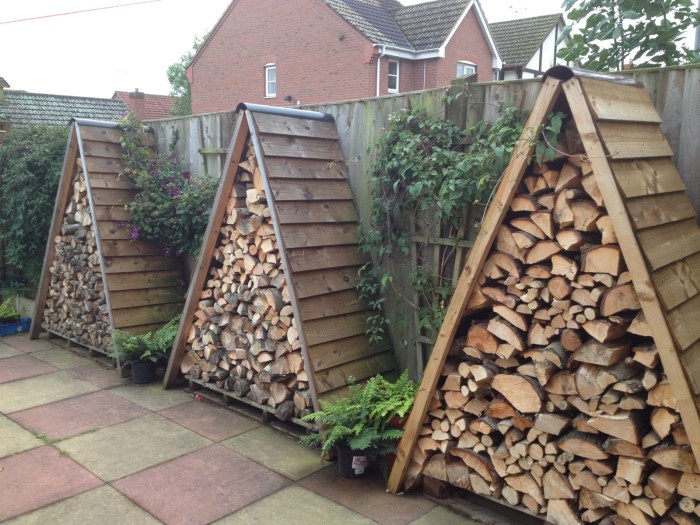In the realm of outdoor living, log stores are not mere storage solutions; they are canvases for creativity and functional masterpieces. With our curated guide to outdoor log store ideas, we embark on a journey to transform your firewood haven into an aesthetically pleasing and practical addition to your outdoor sanctuary.
From design considerations and storage capacity to weather resistance and pest control, we delve into every aspect of log store design, empowering you to create a storage solution that not only keeps your logs dry and organized but also complements your outdoor aesthetic.
Design Considerations
Outdoor log stores should be designed to keep logs dry, organized, and easily accessible. Consider the following key elements when planning your outdoor log store:
Size:Determine the size of the log store based on your wood consumption and storage needs.
Shape:Choose a shape that complements your outdoor space and provides optimal storage capacity.
Material:Select durable materials that can withstand outdoor elements, such as pressure-treated wood, metal, or stone.
Ventilation:Ensure proper ventilation to prevent moisture buildup and promote air circulation.
Accessibility:Design the log store for easy access to logs, whether you’re using a wheelbarrow or carrying them by hand.
Style:Choose a design style that complements your outdoor décor and personal preferences.
Choosing Materials
The choice of materials for your outdoor log store depends on factors such as durability, cost, and aesthetics. Consider the following materials:
- Pressure-treated wood:Durable and affordable, but requires regular maintenance to prevent rot and insect damage.
- Metal:Rust-resistant and durable, but can be more expensive than wood.
- Stone:Long-lasting and fire-resistant, but can be heavy and expensive.
- Recycled materials:Creative and environmentally friendly, but may not be as durable as traditional materials.
Design Styles
Outdoor log stores come in a variety of design styles to suit different tastes and outdoor spaces:
- Traditional:Classic designs with simple lines and rustic charm.
- Modern:Sleek and contemporary designs with clean lines and geometric shapes.
- Rustic:Natural and rugged designs using materials like untreated wood or stone.
- Industrial:Urban-inspired designs with exposed metal and concrete elements.
Storage Capacity
Determining the appropriate storage capacity for your outdoor log store is crucial to ensure it meets your needs without becoming excessive or inefficient.
To calculate the required space, consider the following factors:
Usage Patterns
- Estimate the frequency and quantity of firewood usage during the season.
- Account for potential variations in usage due to weather conditions or changes in heating habits.
Log Dimensions
- Measure the length, width, and height of the logs you intend to store.
- Consider the type of wood and its density, as different species vary in size and weight.
Stacking Efficiency
- Plan for an efficient stacking method to maximize space utilization.
- Consider using a log rack or pallets to elevate the logs and improve air circulation.
Seasoning Period
- Allow for additional space if you plan to season the logs before use.
- Properly seasoned firewood burns more efficiently and produces less smoke.
By considering these factors and incorporating efficient storage practices, you can determine the optimal storage capacity for your outdoor log store.
Weather Resistance
Outdoor log stores require weather resistance to protect logs from deterioration caused by rain, snow, and wind. Durable materials and construction techniques ensure longevity and maintain the quality of the logs.
Materials like pressure-treated wood, galvanized steel, or plastic resist moisture and decay. Proper construction involves a sloped roof to shed water, raised legs for ventilation, and secure joints to prevent wind damage.
Protecting Logs from the Elements
Additional measures can enhance protection:
- Covering the store with a tarp or plastic sheeting during extreme weather
- Storing logs off the ground to prevent moisture absorption
- Rotating logs regularly to ensure even drying and prevent mold
Accessibility and Convenience: Outdoor Log Store Ideas
Retrieving logs from your outdoor log store should be effortless and convenient. Design your log store with accessibility in mind, ensuring logs are easily reachable and retrievable.
Consider incorporating features like a raised base or slanted platform to reduce bending and make it easier to load and unload logs. Provide ample space around the log store for easy access and maneuverability.
Ergonomic Principles
Incorporate ergonomic principles to minimize strain and fatigue when handling logs. Use handles or grips on the log store to facilitate easy lifting and carrying. Design the log store with a comfortable working height to avoid excessive bending or reaching.
Aesthetics and Integration

Log stores are not just functional elements but can also contribute to the overall aesthetic appeal of outdoor spaces. They can be integrated seamlessly into different landscape designs, adding a touch of rustic charm or modern elegance.
When choosing a log store, consider the style of your outdoor space. For traditional gardens, opt for classic log stores made of natural materials like wood or stone. Contemporary landscapes may call for sleek and modern designs crafted from metal or concrete.
Placement and Landscaping
- Place log stores strategically to enhance the visual flow of your outdoor space. Use them as focal points or to define different areas.
- Surround log stores with plants, shrubs, or flowers to create a natural and inviting ambiance. Climbing plants can soften the look of a log store and add a touch of greenery.
- Incorporate log stores into raised beds or seating areas, creating functional and visually appealing structures.
Examples of Aesthetic Log Stores
- Rustic Charm:A log store made of stacked firewood with a weathered finish adds a touch of cozy charm to a traditional garden.
- Modern Elegance:A sleek, metal log store with a geometric design complements a contemporary outdoor space.
- Natural Integration:A log store built into a retaining wall, using natural stone or wood, blends seamlessly into the landscape.
Fire Safety Considerations
Ensure the safety of your outdoor log storage by adhering to fire safety regulations and best practices. Proper placement and distance from structures, along with fire-resistant materials and construction methods, are crucial to minimize fire risk.
Placement and Distance
Position your log store a safe distance from structures, including your home, shed, or other buildings. Check local regulations for specific requirements, which typically range from 10 to 50 feet. Consider prevailing wind patterns to prevent embers from drifting towards flammable materials.
Materials and Construction
Choose fire-resistant materials like concrete or metal for your log store’s base and walls. Use non-combustible roofing materials and ensure adequate ventilation to prevent heat buildup. Avoid storing logs directly on the ground, as moisture can promote decay and increase fire risk.
Ventilation and Airflow
Proper ventilation is crucial for preventing log decay. Moisture buildup from rain, snow, or condensation can lead to rot and deterioration. Design features that promote airflow, such as open sides, elevated bases, and gaps between logs, are essential for keeping logs dry and well-ventilated.
Design Considerations
- Elevate the log store on a platform or pallets to improve air circulation beneath the logs.
- Provide open sides or gaps between logs to allow air to flow freely.
- Consider using a log store with a slatted or mesh bottom to facilitate drainage and airflow.
Pest Control and Prevention
Pests like insects, rodents, and birds can infest outdoor log stores, contaminating the logs and making them unusable. Implementing effective pest control measures is crucial to maintain a clean and pest-free storage environment.
Prevention Strategies
Keep the area clean
Regularly remove any debris, wood chips, or sawdust that can attract pests.
Store logs off the ground
Elevate logs on pallets or a raised platform to prevent ground moisture and insects from reaching them.
Cover the logs
Use a tarp or cover to protect logs from rain, snow, and pests. Ensure proper ventilation to prevent moisture buildup.
Seal any cracks or holes
Inspect the storage area for any gaps or openings and seal them to prevent pest entry.
Use natural repellents
Scatter mothballs or cedar chips around the storage area to deter insects.
DIY Log Store Projects
Build a functional and stylish log store for your outdoor space with these DIY projects.
Materials and Tools
Organize your materials and tools before starting any DIY log store project. Essential materials include wood, nails, screws, and protective finishes. You’ll also need measuring tools, a saw, a drill, and a hammer or nail gun.
Simple Log Store
A basic log store can be built using a few wooden pallets. Stack the pallets vertically, securing them with nails or screws. Add a roof made of plywood or corrugated metal for protection from the elements.
Lean-to Log Store
A lean-to log store is attached to a wall or fence for added stability. Build a frame using 4×4 posts and attach it to the wall. Cover the frame with plywood or siding, leaving an open front for access to the logs.
Elevated Log Store
An elevated log store keeps logs off the ground, preventing rot and pests. Build a platform using 4×4 posts and plywood. Install a ramp or stairs for easy access to the logs.
Decorative Log Store
Add a touch of style to your log store by incorporating decorative elements. Paint or stain the wood, add carved designs, or use unique materials like reclaimed wood or stone.
Conclusion
DIY log store projects are a great way to organize and protect your firewood while adding a functional and stylish element to your outdoor space. With careful planning and execution, you can create a log store that meets your specific needs and complements your backyard décor.
Commercial Log Store Solutions
When considering commercial log store solutions, various options are available, each with unique features, benefits, and drawbacks. Understanding these factors is crucial for selecting the most suitable option.
Metal Log Stores
- Features:Durable, weather-resistant, easy to assemble.
- Benefits:Long-lasting, protect logs from elements, organized storage.
- Drawbacks:Can be expensive, may require maintenance.
Wooden Log Stores, Outdoor log store ideas
- Features:Aesthetically pleasing, eco-friendly, various designs.
- Benefits:Natural look, blends with surroundings, affordable.
- Drawbacks:Requires regular maintenance, susceptible to rot and pests.
Plastic Log Stores
- Features:Lightweight, easy to clean, weather-resistant.
- Benefits:Convenient, low maintenance, protects logs from moisture.
- Drawbacks:Less durable than metal or wood, may fade over time.
Choosing the Most Suitable Option
Consider the following factors when selecting a commercial log store solution:
- Budget:Determine the available financial resources.
- Log Storage Capacity:Estimate the amount of logs to be stored.
- Durability and Maintenance:Assess the required lifespan and maintenance efforts.
- Aesthetics:Choose a solution that complements the surrounding environment.
By carefully considering these factors, you can make an informed decision that meets your specific needs and preferences.
Log Store Maintenance and Upkeep

Regular maintenance is crucial for log stores to ensure their durability, functionality, and safety. A well-maintained log store will protect your firewood from moisture, pests, and fire hazards, extending its lifespan and ensuring a steady supply of dry firewood.
Maintenance Checklist
-
-*Inspect the structure
Check for any cracks, loose joints, or signs of damage. Repair or replace damaged parts promptly to maintain structural integrity.
-*Clean the log store
Remove any debris, leaves, or sawdust that may accumulate over time. This prevents moisture buildup and reduces the risk of pest infestations.
-*Check ventilation
Ensure that the log store has adequate ventilation to prevent moisture buildup and promote airflow. Clean any blocked vents or air holes.
-*Treat for pests
Inspect the log store regularly for signs of pests such as termites or woodworms. Treat the store with appropriate pest control measures if necessary.
-*Re-stain or paint
If the log store is painted or stained, re-apply a protective coating every few years to maintain its appearance and protect it from the elements.
Closing Summary

As we conclude our exploration of outdoor log store ideas, remember that the perfect log store is a harmonious blend of functionality, durability, and visual appeal. By incorporating our expert insights and innovative design ideas, you can create a log store that not only serves its purpose but also enhances the overall ambiance of your outdoor space.
Answers to Common Questions
What is the optimal height for an outdoor log store?
The ideal height for an outdoor log store is between 3 and 4 feet, ensuring easy access to logs while protecting them from ground moisture.
How do I protect my log store from pests?
To prevent pest infestations, elevate your log store off the ground, keep it well-ventilated, and consider using pest-resistant materials like cedar or redwood.
Can I build my own outdoor log store?
Absolutely! DIY log store projects are a great way to customize your storage solution and save money. Our guide includes step-by-step instructions for various DIY projects.


